SSANGYONG NEW ACTYON SPORTS 2013 Service Manual
Manufacturer: SSANGYONG, Model Year: 2013, Model line: NEW ACTYON SPORTS, Model: SSANGYONG NEW ACTYON SPORTS 2013Pages: 751, PDF Size: 72.63 MB
Page 461 of 751

01-153680-01
2) Mode “M” (Manual Shift Mode)
This allows the driver to define the highest possible gear by selecting "+" or "-" on the gear selector when
the lever is in the "M" position. When the lever is first moved to the manual "M" position the transmission
will select the lowest possible gear.
When maximum engine rpm is reached the transmission will upshift automatically regardless of the
driver selected limit. 4WD models with low range will not automatically upshift when low range is
selected.
1st gear position ▶
2nd gear position ▶
3st gear position ▶
4th gear position ▶
5th gear position ▶
6th gear position ▶Use on a rugged road, mountain path and steep hill. Engine braking effect on steep hill is
available. -
Use on a long and gentle slope. 2-1 automatic kickdown shift is available. Engine braking effect is
available. -
Use on a long and gentle slope. 3-2 and 2-1 automatic kickdown shift is available. Engine
braking effect is available. -
Use on a long and gentle slope. 4-3, 4-2 and 4-1 automatic kickdown shift is available. -
5-4 and 5-3 automatic kickdown shift is available. -
6-5 and 6-4 automatic kickdown shift is available. -
Kickdown Function
If you need to accelerate rapidly, depress the accelerator pedal completely to the floor.
Then, a one- or two-lever gear will automatically be engaged. This is called the Kickdown function.
Page 462 of 751
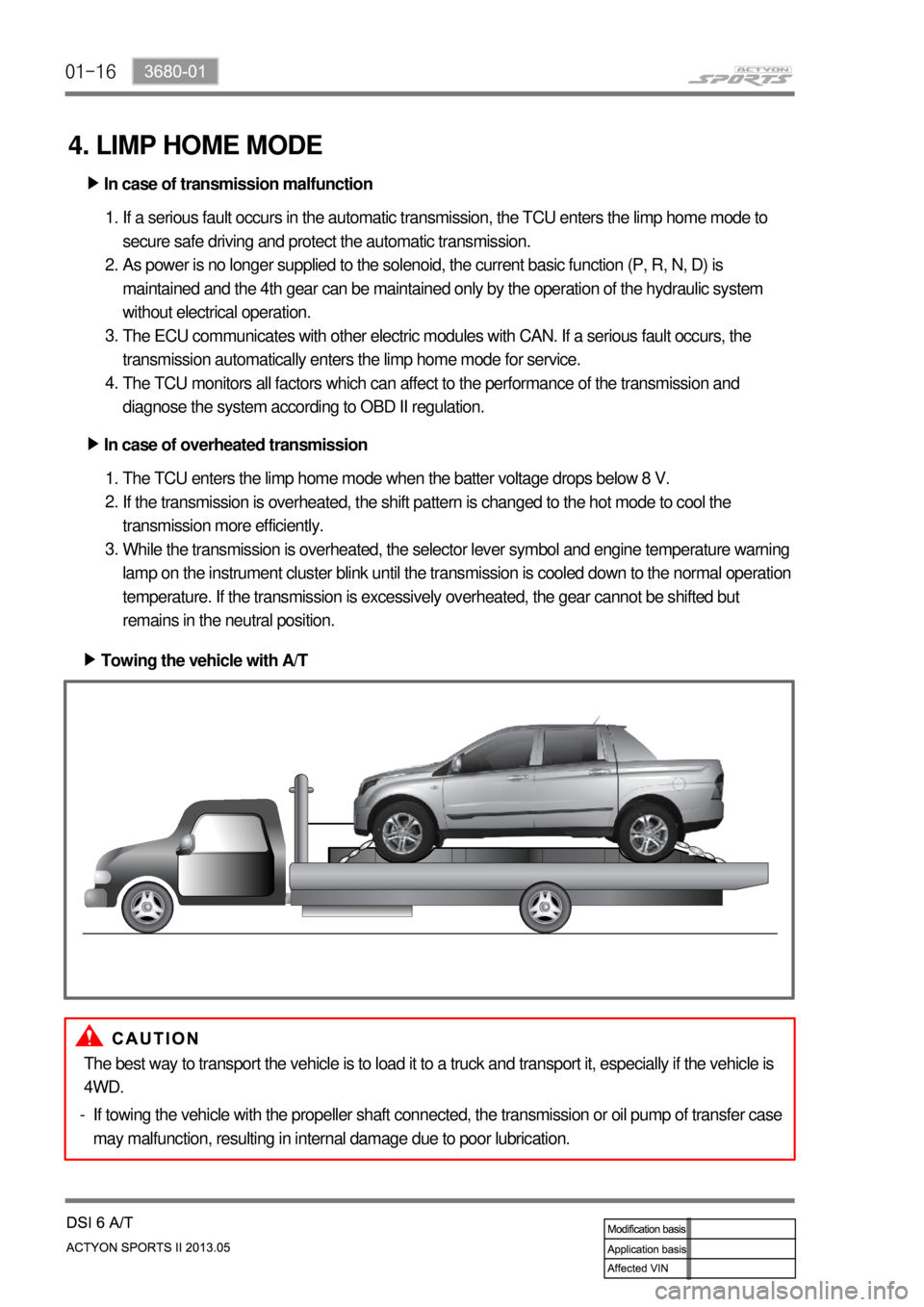
01-16
4. LIMP HOME MODE
In case of transmission malfunction ▶
If a serious fault occurs in the automatic transmission, the TCU enters the limp home mode to
secure safe driving and protect the automatic transmission.
As power is no longer supplied to the solenoid, the current basic function (P, R, N, D) is
maintained and the 4th gear can be maintained only by the operation of the hydraulic system
without electrical operation.
The ECU communicates with other electric modules with CAN. If a serious fault occurs, the
transmission automatically enters the limp home mode for service.
The TCU monitors all factors which can affect to the performance of the transmission and
diagnose the system according to OBD II regulation. 1.
2.
3.
4.
In case of overheated transmission ▶
The TCU enters the limp home mode when the batter voltage drops below 8 V.
If the transmission is overheated, the shift pattern is changed to the hot mode to cool the
transmission more efficiently.
While the transmission is overheated, the selector lever symbol and engine temperature warning
lamp on the instrument cluster blink until the transmission is cooled down to the normal operation
temperature. If the transmission is excessively overheated, the gear cannot be shifted but
remains in the neutral position. 1.
2.
3.
Towing the vehicle with A/T ▶
The best way to transport the vehicle is to load it to a truck and transport it, especially if the vehicle is
4WD.
If towing the vehicle with the propeller shaft connected, the transmission or oil pump of transfer case
may malfunction, resulting in internal damage due to poor lubrication. -
Page 463 of 751
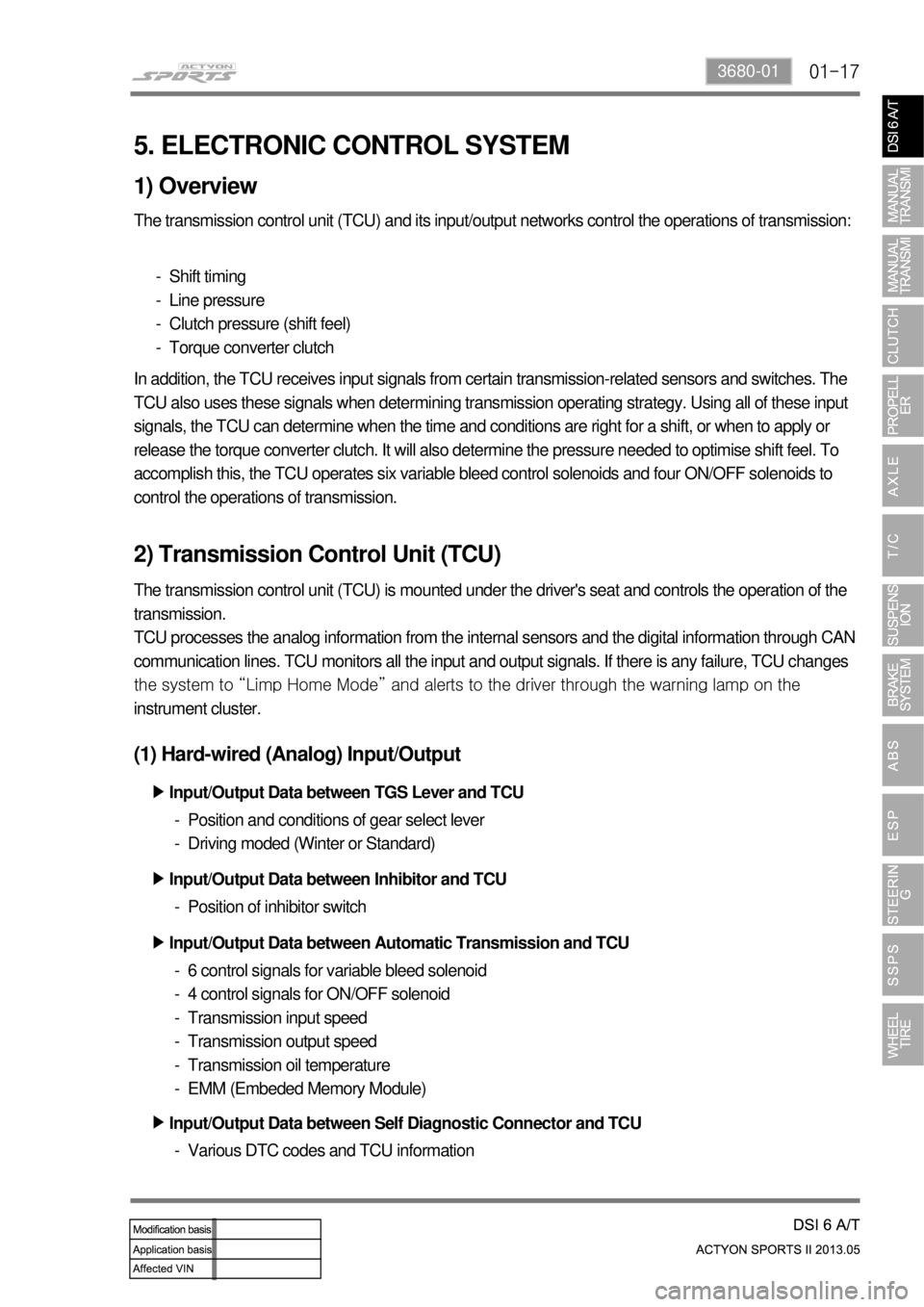
01-173680-01
5. ELECTRONIC CONTROL SYSTEM
1) Overview
The transmission control unit (TCU) and its input/output networks control the operations of transmission:
Shift timing
Line pressure
Clutch pressure (shift feel)
Torque converter clutch -
-
-
-
In addition, the TCU receives input signals from certain transmission-related sensors and switches. The
TCU also uses these signals when determining transmission operating strategy. Using all of these input
signals, the TCU can determine when the time and conditions are right for a shift, or when to apply or
release the torque converter clutch. It will also determine the pressure needed to optimise shift feel. To
accomplish this, the TCU operates six variable bleed control solenoids and four ON/OFF solenoids to
control the operations of transmission.
2) Transmission Control Unit (TCU)
The transmission control unit (TCU) is mounted under the driver's seat and controls the operation of the
transmission.
TCU processes the analog information from the internal sensors and the digital information through CAN
communication lines. TCU monitors all the input and output signals. If there is any failure, TCU changes
the system to “Limp Home Mode” and alerts to the driver through the warning lamp on the
instrument cluster.
(1) Hard-wired (Analog) Input/Output
Input/Output Data between TGS Lever and TCU ▶
Position and conditions of gear select lever
Driving moded (Winter or Standard) -
-
Position of inhibitor switch - Input/Output Data between Inhibitor and TCU ▶
6 control signals for variable bleed solenoid
4 control signals for ON/OFF solenoid
Transmission input speed
Transmission output speed
Transmission oil temperature
EMM (Embeded Memory Module) -
-
-
-
-
- Input/Output Data between Automatic Transmission and TCU ▶
Input/Output Data between Self Diagnostic Connector and TCU ▶
Various DTC codes and TCU information -
Page 464 of 751

01-18
(2) CAN Input/Output
TCU receives and sends the data among the units through P-CAN communication.
CAN Input/Output Data between Engine ECU and TCU ▶
Page 465 of 751

01-193680-01
CAN Input/Output Data between ABS/ESP and TCU ▶
CAN Input/Output Data between TCCU and TCU ▶
CAN Input/Output Data between ICM and TCU ▶
Page 466 of 751
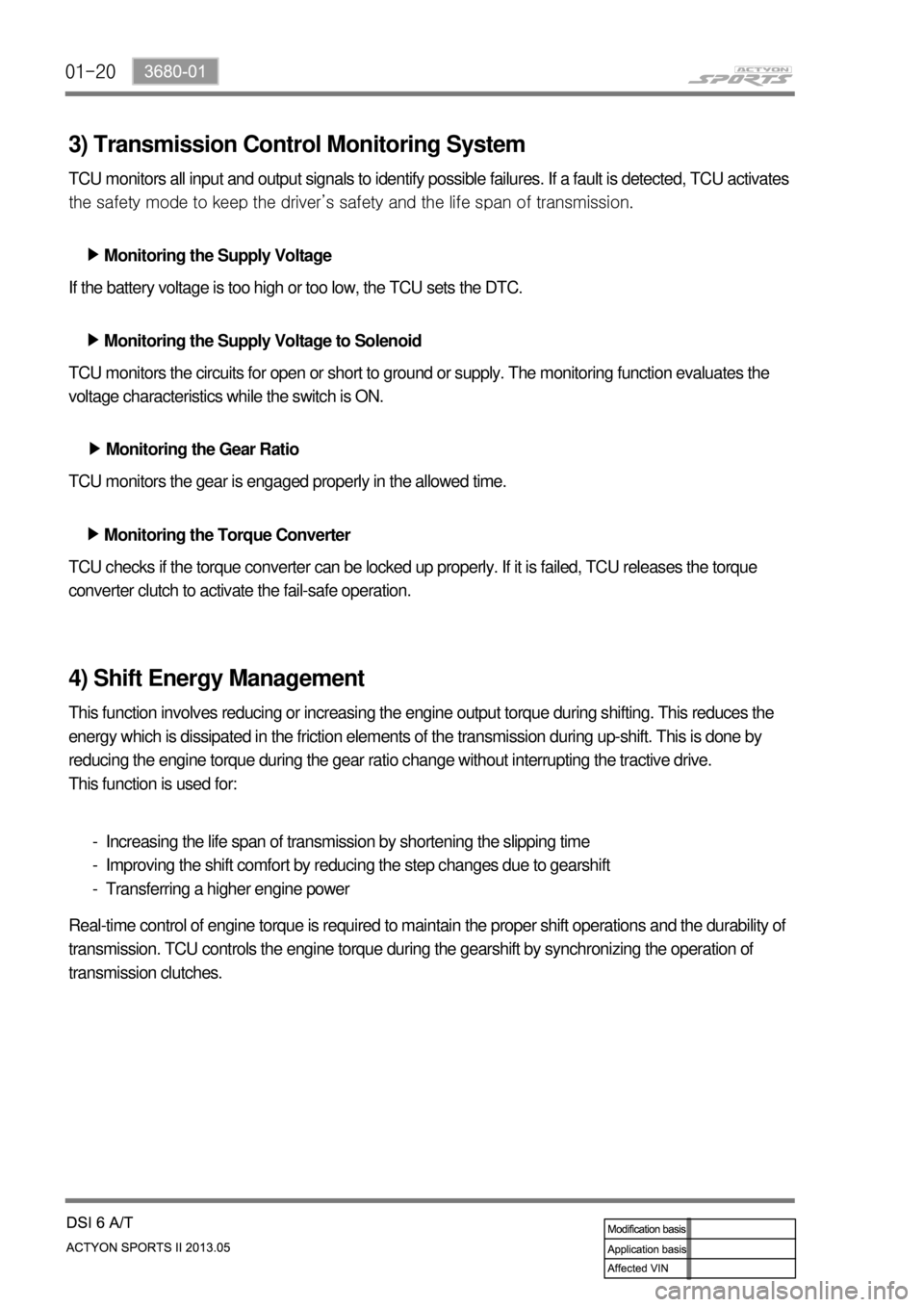
01-20
3) Transmission Control Monitoring System
TCU monitors all input and output signals to identify possible failures. If a fault is detected, TCU activates
<009b008f008c0047009a0088008d008c009b00a0004700940096008b008c0047009b009600470092008c008c00970047009b008f008c0047008b00990090009d008c009902c5009a0047009a0088008d008c009b00a0004700880095008b0047009b008f00
8c004700930090008d008c0047009a00970088009500470096>f transmission.
Monitoring the Supply Voltage ▶
Monitoring the Supply Voltage to Solenoid ▶
Monitoring the Gear Ratio ▶
Monitoring the Torque Converter ▶ If the battery voltage is too high or too low, the TCU sets the DTC.
TCU monitors the circuits for open or short to ground or supply. The monitoring function evaluates the
voltage characteristics while the switch is ON.
TCU monitors the gear is engaged properly in the allowed time.
TCU checks if the torque converter can be locked up properly. If it is failed, TCU releases the torque
converter clutch to activate the fail-safe operation.
4) Shift Energy Management
This function involves reducing or increasing the engine output torque during shifting. This reduces the
energy which is dissipated in the friction elements of the transmission during up-shift. This is done by
reducing the engine torque during the gear ratio change without interrupting the tractive drive.
This function is used for:
Increasing the life span of transmission by shortening the slipping time
Improving the shift comfort by reducing the step changes due to gearshift
Transferring a higher engine power -
-
-
Real-time control of engine torque is required to maintain the proper shift operations and the durability of
transmission. TCU controls the engine torque during the gearshift by synchronizing the operation of
transmission clutches.
Page 467 of 751
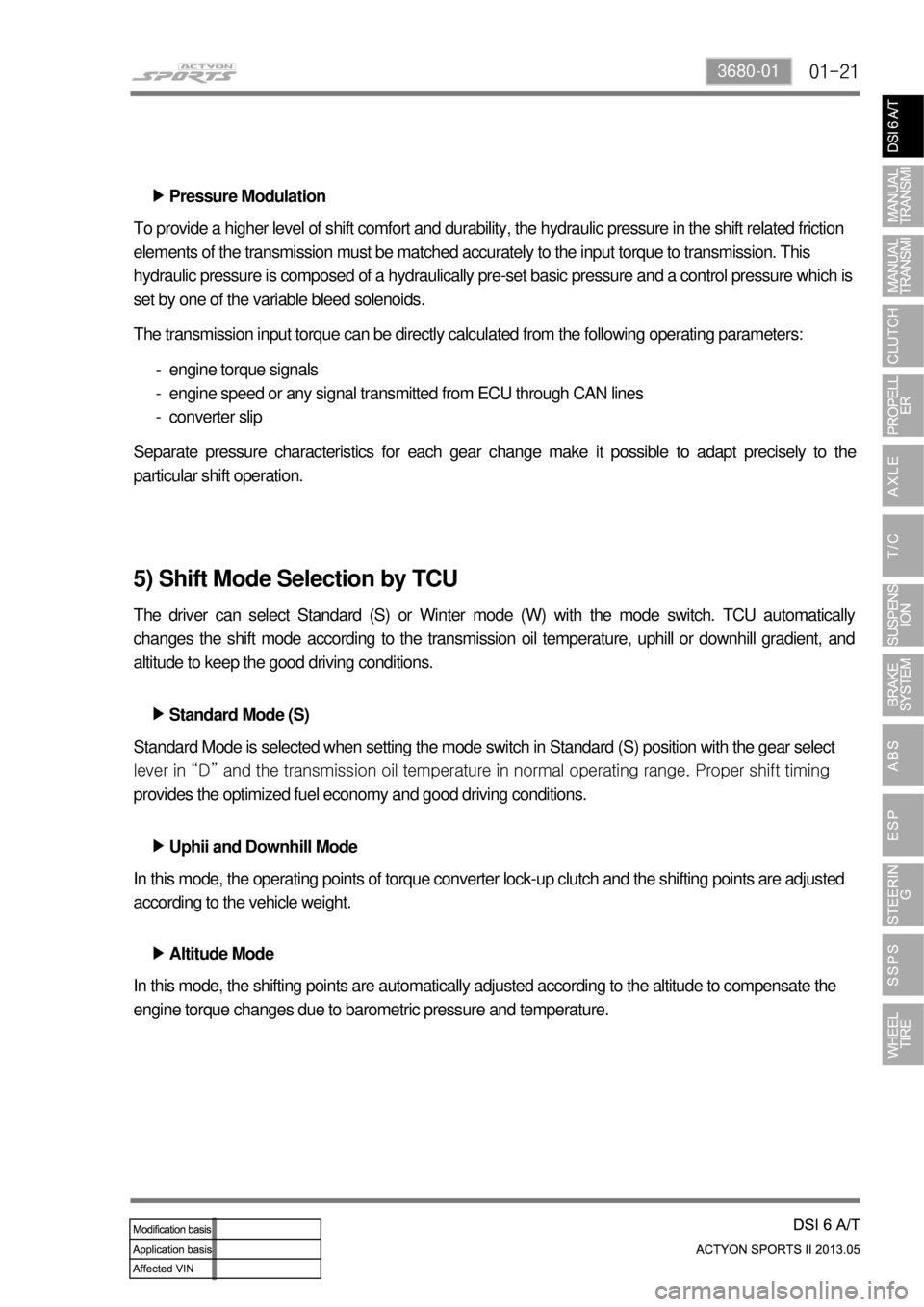
01-213680-01
Pressure Modulation ▶
To provide a higher level of shift comfort and durability, the hydraulic pressure in the shift related friction
elements of the transmission must be matched accurately to the input torque to transmission. This
hydraulic pressure is composed of a hydraulically pre-set basic pressure and a control pressure which is
set by one of the variable bleed solenoids.
The transmission input torque can be directly calculated from the following operating parameters:
engine torque signals
engine speed or any signal transmitted from ECU through CAN lines
converter slip -
-
-
Separate pressure characteristics for each gear change make it possible to adapt precisely to the
particular shift operation.
5) Shift Mode Selection by TCU
The driver can select Standard (S) or Winter mode (W) with the mode switch. TCU automatically
changes the shift mode according to the transmission oil temperature, uphill or downhill gradient, and
altitude to keep the good driving conditions.
Standard Mode (S) ▶
Uphii and Downhill Mode ▶
Altitude Mode ▶ Standard Mode is selected when setting the mode switch in Standard (S) position with the gear select
<0093008c009d008c0099004700900095004702c8006b02c9004700880095008b0047009b008f008c0047009b009900880095009a00940090009a009a00900096009500470096009000930047009b008c00940097008c00990088009b009c0099008c004700
9000950047009500960099009400880093004700960097008c>rating range. Proper shift timing
provides the optimized fuel economy and good driving conditions.
In this mode, the operating points of torque converter lock-up clutch and the shifting points are adjusted
according to the vehicle weight.
In this mode, the shifting points are automatically adjusted according to the altitude to compensate the
engine torque changes due to barometric pressure and temperature.
Page 468 of 751
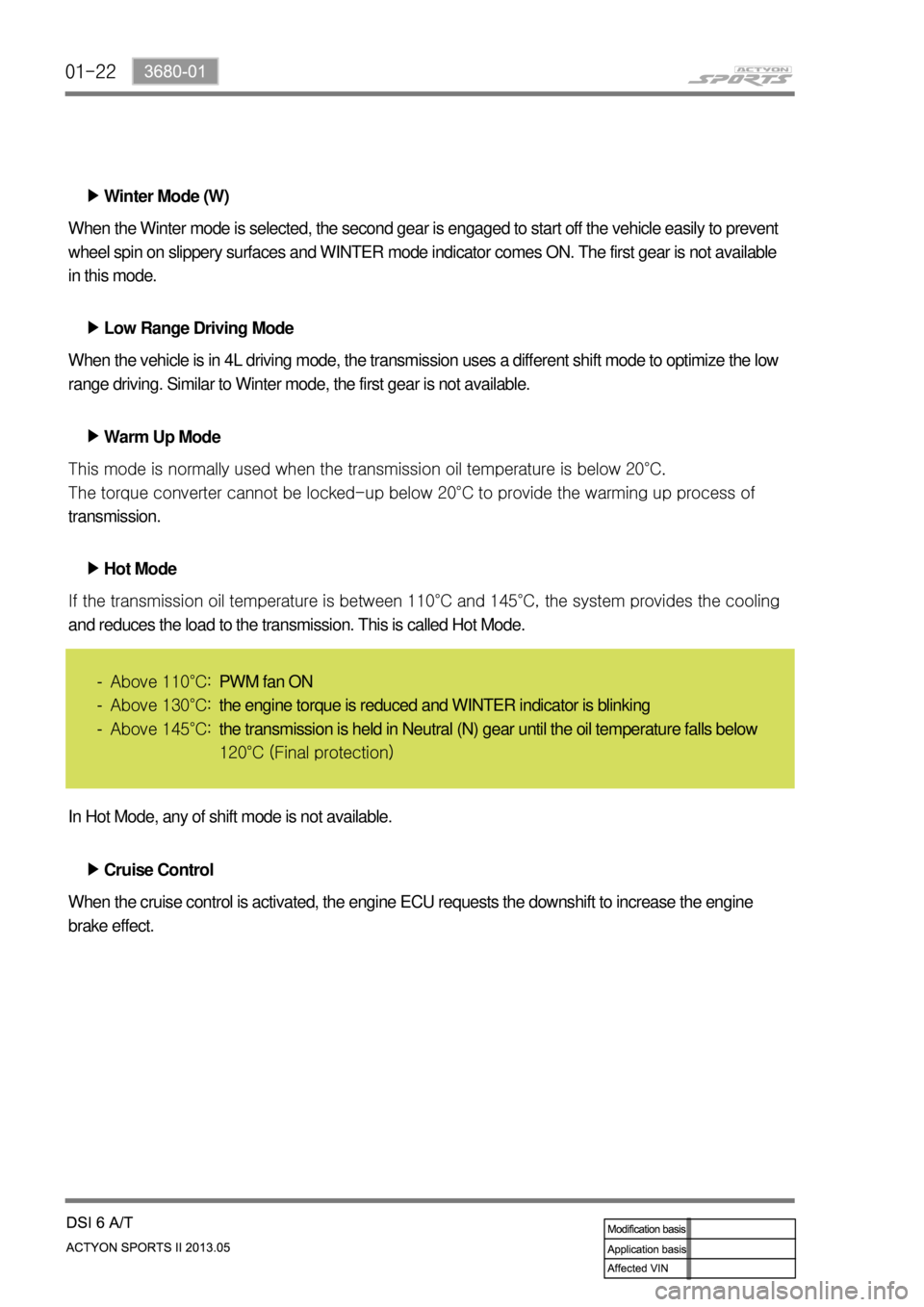
01-22
Winter Mode (W) ▶
Low Range Driving Mode ▶
Warm Up Mode ▶ When the Winter mode is selected, the second gear is engaged to start off the vehicle easily to prevent
wheel spin on slippery surfaces and WINTER mode indicator comes ON. The first gear is not available
in this mode.
When the vehicle is in 4L driving mode, the transmission uses a different shift mode to optimize the low
range driving. Similar to Winter mode, the first gear is not available.
This mode is normally used when the transmission oil temperature is below 20°C.
<007b008f008c0047009b009600990098009c008c0047008a00960095009d008c0099009b008c00990047008a0088009500950096009b00470089008c004700930096008a0092008c008b0054009c009700470089008c00930096009e00470059005700b600
6a0047009b00960047009700990096009d0090008b008c0047>the warming up process of
transmission.
Hot Mode ▶
<0070008d0047009b008f008c0047009b009900880095009a00940090009a009a00900096009500470096009000930047009b008c00940097008c00990088009b009c0099008c00470090009a00470089008c009b009e008c008c0095004700580058005700
b6006a004700880095008b00470058005b005c00b6006a0053> the system provides the cooling
and reduces the load to the transmission. This is called Hot Mode.
Above 110°C:
Above 130°C:
Above 145°C: -
-
-
In Hot Mode, any of shift mode is not available.
Cruise Control ▶
When the cruise control is activated, the engine ECU requests the downshift to increase the engine
brake effect.PWM fan ON
the engine torque is reduced and WINTER indicator is blinking
the transmission is held in Neutral (N) gear until the oil temperature falls below
120°C (Final protection)
Page 469 of 751

01-233680-01
6. POWER FLOW
Power flows in gears:
Power flow - 1st gear (M)
Power flow - 1st gear (D)
Power flow - 2nd gear (D)
Power flow - 2nd gear (D) ? lockup (D)
Power flow - 3rd gear (D)
Power flow - 4th gear (D) - 4th gear (D) in Limp home mode
Power flow - 5th gear (D)
Power flow - 6th gear (D) -
-
-
-
-
-
-
-
GearGear ratioEngaged element (clutch & band)
C1 C2 C3 B1 B2 1-2OWC
M1 3.53 ON ON
1st 3.53 ON ON
2nd 2.14 ON ON
3rd 1.48 ON ON
4th 1.16 ON ON
5th 0.87 ON ON
6th 0.68 ON ON
Reverse -3.09 ON ON
Gear
S1 S2 S3 S4 S5(A) S6(A) S7(A) S8(A) S9(A) S10(A)
M1 ON 1 0 1
1st ON 1 0 0-1
2nd ON ON 1 0 1 0-1
3rd ON ON 1 0 1 0-1
4th 0 0 0-1
5th ON 0 1 1 0-1
6th ON ON 0 1 1 0-1
Reverse ON ON ON 1 1 1 0-1
Gear Selection and Engaged Element ▶
Variable bleed solenoid valve - VBS ON/OFF solenoid valve
Page 470 of 751

01-24
Hydraulic Circuit Diagram ▶